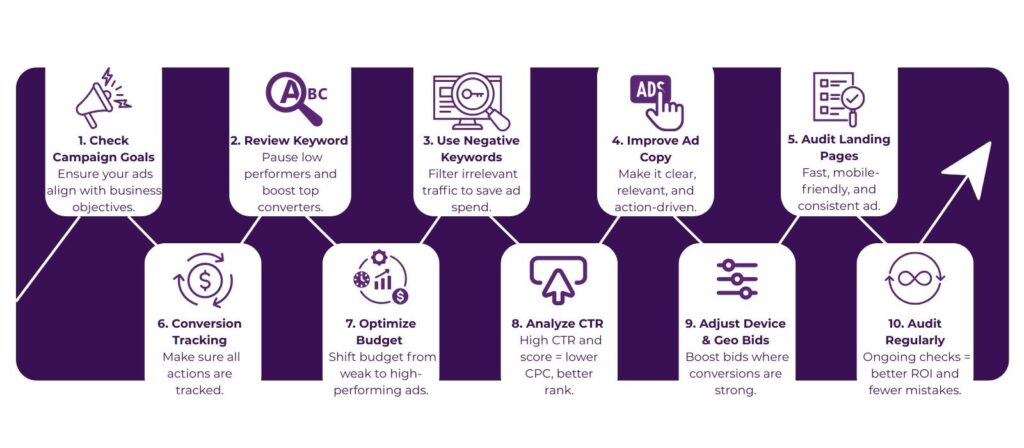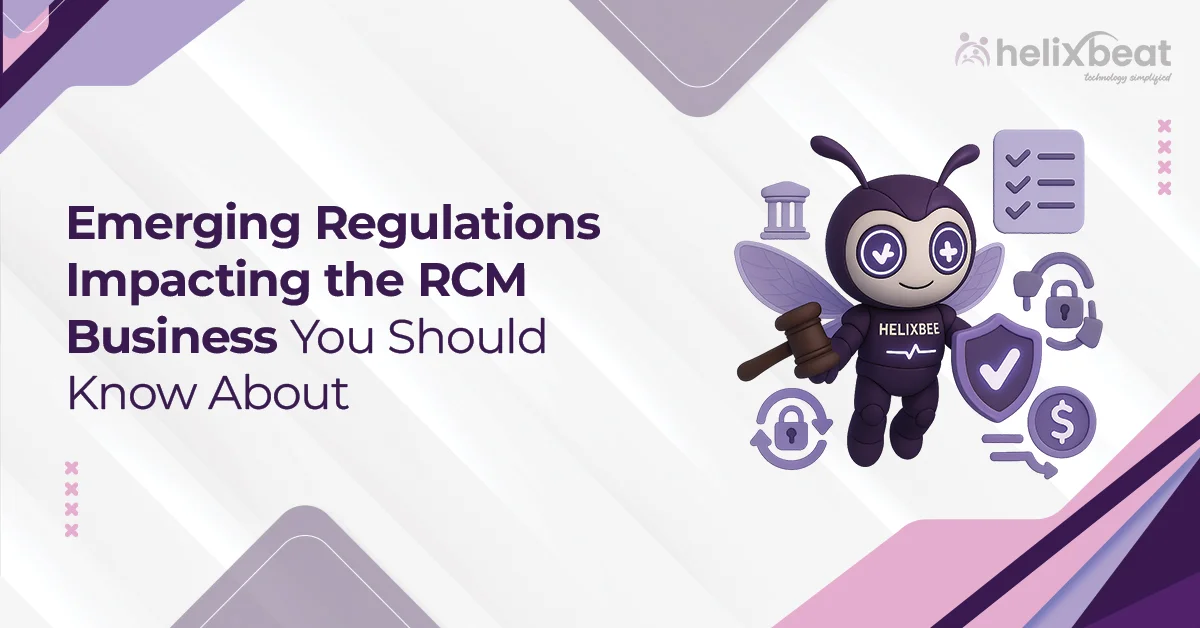Pay-per-click advertising is an effective way to drive targeted traffic and increase sales, but evaluating the success of your campaigns is crucial. A PPC audit thoroughly reviews your campaigns to assess performance, identify inefficiencies, and uncover areas for improvement.
Research shows that businesses that perform PPC audits can achieve a 30% increase in conversion rates and a 25% reduction in wasted ad spend within a few months. Whether you manage ads in-house or with a pay-per-click advertising company, conducting a detailed PPC audit is vital for long-term success in digital advertising.

Table of Contents
Understanding PPC Services and Pay-Per-Click Advertising Companies
PPC stands for Pay-Per-Click, a digital advertising model where advertisers pay a fee each time their ad is clicked. A PPC audit entails a thorough review of your pay-per-click campaigns to evaluate their performance, efficiency, and alignment with business objectives.
A pay-per-click advertising company, also known as a pay-per-click agency, specialises in managing and optimizing PPC campaigns across various platforms, including Google Ads, Bing Ads, and social media networks.
How to Audit PPC Campaigns? Tips to Approach
A PPC audit checklist serves as a detailed guide that outlines essential elements and metrics to be examined during a PPC campaign evaluation. This checklist ensures that no important aspect is missed, enabling advertisers, pay-per-click marketing agencies, and Google Ads specialists to pinpoint both weaknesses and strengths in their strategies.
Think of it as a quality control tool for PPC services, facilitating regular campaign health assessments that promote ongoing improvements.
Tips for Conducting an Effective Audit Checklist:
- Set Clear Goals
- Collect Reliable Data
- Work Through the Checklist Methodically
- Identify Quick Wins and Long-Term Improvements
- Document Findings Clearly
- Utilize Benchmarks and Industry Insights
The 25-Step PPC Audit Checklist
Below is a detailed checklist to help you evaluate every critical aspect of your pay-per-click advertising efforts:
1. Review Campaign Goals and KPIs
Start by reassessing your campaign objectives. Whether your aim is lead generation, sales, or brand awareness, your KPIs, such as click-through rate (CTR), conversion rate, or cost per acquisition (CPA), must align with these goals. Clear goals allow you to measure success accurately and pivot when needed.
2. Analyze Account Structure
A well-organised account structure improves management and performance. Verify that product categories, services, or target demographics are logically segmented across campaigns and ad groups. This segmentation enables your pay-per-click advertising company to deliver precise targeting and budget control, thereby avoiding wasted spending.
3. Evaluate Keyword Performance
Use your PPC data to identify both top-performing and underperforming keywords. Analyze keyword relevance, search volume, and conversion rates. Remove or pause irrelevant keywords to improve ROI and optimize bids on high-value terms.
4. Check Match Types & Negative Keywords
Match types, such as exact, phrase, or broad, control how broadly your ads reach users. Ensure you are using these strategically to balance reach and precision. Negative keywords are equally crucial—they prevent ads from showing up in irrelevant searches, thereby reducing wasted spend.
5. Assess Ad Copy Quality
Ad copy must be compelling, relevant, and aligned with user intent. Review headlines and descriptions for clarity and ensure they include strong calls to action. High-quality ad copy drives better CTR and lowers CPC by increasing your Quality Score.
6. Review the Landing Page Experience
A smooth, relevant landing page experience is key to converting clicks into customers. Evaluate page load speed, mobile optimization, and content consistency with ad messaging. Google reports a 20% drop in conversions when landing pages take longer than three seconds to load.
7. Monitor Quality Score
The Quality Score reflects ad relevance, expected click-through rate (CTR), and landing page experience. Regularly check keyword-level scores to identify issues dragging down your campaign’s efficiency and costs.
8. Analyze Click-Through Rate (CTR)
CTR indicates how well your ads engage users. Compare CTR across campaigns, ad groups, and devices to identify areas that need improvement or re-targeting.
9. Examine Conversion Tracking Accuracy
Verify that all tracking codes and pixels are installed correctly and firing on intended actions. Inaccurate tracking can skew data, leading to poor budget allocation and misguided decisions.
10. Evaluate Budget Allocation & Spend
Assess whether your daily and monthly budgets align with campaign goals and performance. Overspending on low-performing campaigns wastes money while underspending on winning campaigns limits growth.
11. Inspect Device & Location Targeting
Analyse performance metrics by device (desktop, mobile, tablet) and geographic location. For example, mobile users may convert more effectively in specific industries, justifying higher bids on mobile devices or specific locations.
12. Review Ad Extensions Usage
Ad extensions, such as site links, callouts, and structured snippets, increase ad real estate engagement. Ensure you’re utilizing all relevant extensions to enhance click-through rates (CTR) and overall ad performance.
13. Analyze Competitor Performance
Utilize auction insights to assess competitor activity and pinpoint opportunities to refine your bids or ad copy. Staying ahead of the competition helps you capture a larger market share.
14. Check for Campaign Overlaps
Look for overlapping keywords or audience targeting between campaigns to ensure consistency. Overlaps can lead to internal bidding wars, resulting in increased CPC without added value.
15. Measure ROI & Cost Per Acquisition (CPA)
Calculate the true ROI and CPA of each campaign. Compare these metrics against industry benchmarks to identify cost-effective campaigns and those that require optimization.
16. Audit Search Term Reports
Review actual search queries that triggered your ads. Identify irrelevant queries to add as negative keywords and spot new opportunities to expand keyword lists.
17. Verify Ad Scheduling
Analyze performance by day and day of the week. Adjust ad schedules to focus on spending during peak engagement and conversion times.
18. Assess Audience Targeting
Evaluate how remarketing lists, customer matches, and in-market audiences perform. Effective audience segmentation enhances relevance and boosts conversion rates.
19. Evaluate Ad Frequency and Impression Share
High ad frequency can lead to audience fatigue, while low impression shares signals miss visibility. Balance frequency and bid aggressively where opportunity is high.
20. Test Responsive Search Ads and Dynamic Ads
Responsive ads adapt to user searches, improving relevance. Test these alongside dynamic ads to maximize reach and performance.
21. Review Geographic Bid Adjustments
Adjust bids based on location performance. Increase bids in high-converting regions to capture more qualified traffic.
22. Inspect Device Bid Modifiers
Set bid adjustments for devices based on conversion performance. For example, decrease bids on devices with poor conversion rates to improve the overall return on investment (ROI).
23. Monitor Campaign Type Mix
Ensure a balanced mix of search, display, shopping, and video campaigns suited to your marketing funnel and audience behavior.
24. Check Ad Policy Compliance
Non-compliant ads risk disapproval or account suspension. Review ads regularly to comply with platform policies and industry regulations.
25. Audit Account Settings and Access Controls
Confirm that user permissions are appropriately managed to prevent unauthorized changes. Secure account settings safeguard your PPC investments.
How to Measure PPC Campaign Success?
Success goes beyond just clicks; it involves tracking specific metrics that reflect how well your campaigns align with your marketing goals and using that data to improve continuously.
To effectively measure PPC campaign success, focus on the following core metrics:
- Click-Through Rate (CTR)
This metric indicates the percentage of users who see your ad and click on it. A higher CTR generally indicates that the ads are relevant and compelling.
- Conversion Rate
More critical than clicks; this shows the percentage of visitors who complete a desired action, such as making a purchase or filling out a lead form. A typical conversion rate for PPC campaigns ranges between 2% and 5%, but optimized campaigns can achieve 10% or more.
- Cost Per Click (CPC)
This metric indicates the amount you pay for each click. Balancing CPC with conversion rates helps you maximize your return on investment (ROI).
- Cost Per Acquisition (CPA)
The CPA indicates the cost of acquiring a customer or lead. Lower CPA with consistent quality leads signifies a well-performing campaign.
- Quality Score
Provided by platforms like Google Ads, it measures the relevance of your ads, keywords, and landing pages impacting your ad rank and CPC.
Common PPC Audit Mistakes to Avoid
By avoiding these common mistakes during your PPC audit, you can unlock significant improvements in campaign efficiency and return on investment (ROI).
- Overlooking Conversion Tracking Errors
- Ignoring Account Structure
- Not Using Negative Keywords
- Underutilizing Ad Extensions
What’s Next?
As marketing expert Neil Patel says, ‘The difference between a good PPC campaign and a great one lies in regular audits and ongoing optimization.’ So Regular PPC audits help uncover hidden issues, optimize budget allocation, and improve overall campaign performance.
Partnering with Helixbeat professional PPC services and trusted pay-per-click advertising firm brings the expertise and advanced tools needed to conduct thorough audits efficiently.
Request a Demo
FAQs
How to audit PPC campaigns?
Start by reviewing campaign goals, checking account structure, analyzing keywords, ad performance, conversion tracking, and budget allocation to identify areas for improvement.
How to measure PPC campaign success?
Success is measured by key metrics like click-through rate (CTR), conversion rate, cost per acquisition (CPA), return on ad spend (ROAS), and overall ROI.
What does PPC mean in an audit?
In an audit, PPC (Pay Per Click) refers to examining paid advertising campaigns to assess performance, spending efficiency, and alignment with business goals.
How to do an audit checklist?
Follow a step-by-step list covering campaign goals, keywords, ad copy, tracking setup, budget, targeting, and performance metrics to systematically evaluate your PPC campaigns.
What is a PPC audit?
A PPC audit is a detailed review of your pay per click advertising account to identify strengths, weaknesses, and opportunities to optimize campaigns for better results.
Why should I conduct a PPC audit?
Conducting a PPC audit helps catch errors, improve ad performance, reduce wasted spend, and maximize the return on your advertising investment.
What is the 15-step PPC audit checklist?
It’s a comprehensive guide that includes reviewing goals, account structure, keywords, match types, ad copy, landing pages, quality score, CTR, conversion tracking, budget, targeting, ad extensions, competition, overlaps, and ROI.














